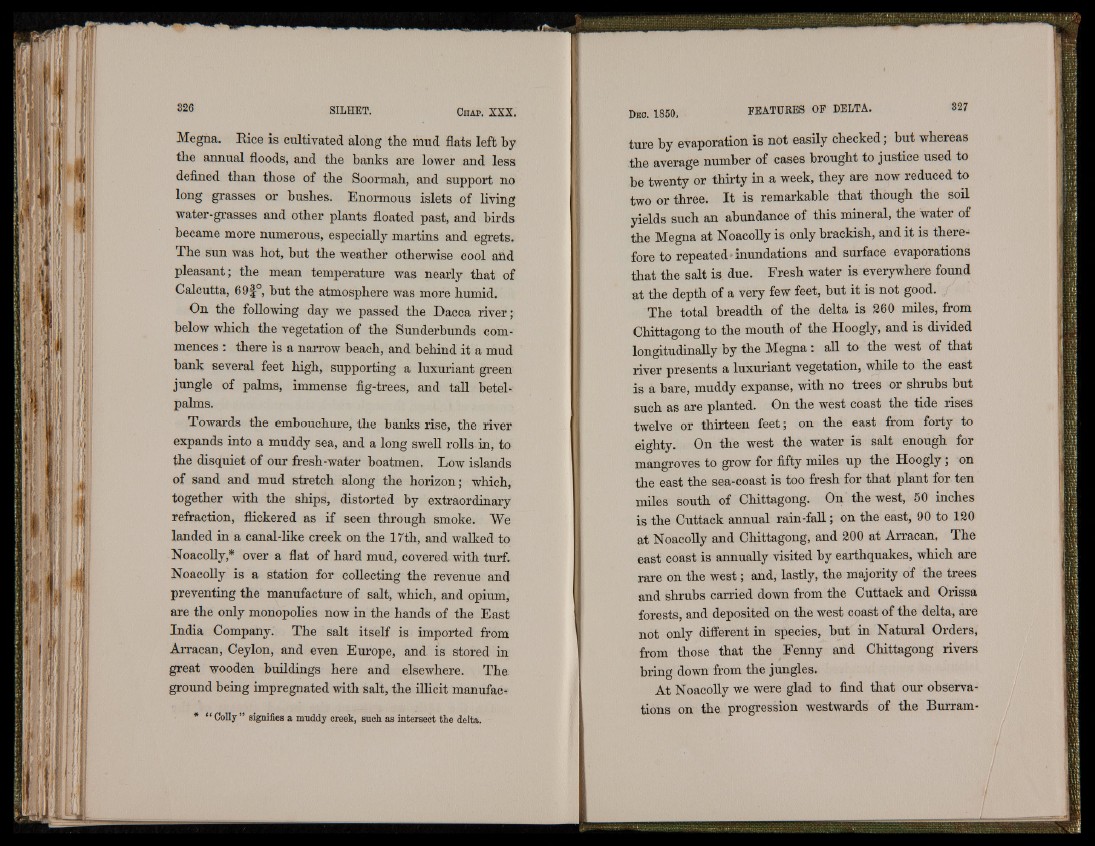
Megna. Eice is cultivated along the mud flats left by
the annual floods, and the banks are lower and less
defined than those of the Soormah, and support no
long grasses or bushes. Enormous islets of living
water-grasses and other plants floated past, and birds
became more numerous, especially martins and egrets.
The sun was hot, but the weather otherwise cool abd
pleasant; the mean temperature was nearly that of
Calcutta, 69f°, but the atmosphere was more humid.
On the following day we passed the Dacca river;
below which the vegetation of the Sunderbunds commences
: there is a narrow beach, and behind it a mud
bank several feet high, supporting a luxuriant green
jungle of palms, immense fig-trees, and tall betel-
palms.
Towards the embouchure, the banks rise, the river
expands into a muddy sea, and a long swell rolls in, to
the disquiet of our fresh-water boatmen, Low islands
of sand and mud stretch along the horizon; which,
together with the ships, distorted by extraordinary
refraction, flickered as if seen through smoke. We
landed in a canal-like creek on the 17th, and walked to
Noacolly,* over a flat of hard mud, covered with turf,
Noacolly is a station for collecting the revenue and
preventing the manufacture of salt, which, and opium,
are the only monopolies now in the hands of the East
India Company. The salt itself is imported from
Arracan, Ceylon, and even Europe, and is stored in
great wooden buildings here and elsewhere. The.
ground being impregnated with salt, the illicit manufac*
“ Colly ” signifies a muddy creek, such as intersect the delta.
ture by evaporation is not easily checked; but whereas
the average number of cases brought to justice used to
be twenty or thirty in a week, they are now reduced to
two or three. I t is remarkable that though the soil
yields such an abundance of this mineral, the water of
the Megna at Noacolly is only brackish, and it is therefore
to repeated * inundations and surface evaporations
that the salt is due. Fresh water is everywhere found
at the depth of a very few feet, but it is not good.
The total breadth of the delta is 260 miles, from
Chittagong to the mouth of the Hoogly, and is divided
longitudinally by the Megna : all to the west of that
river presents a luxuriant vegetation, while to the east
is a bare, muddy expanse, with no trees or shrubs but
such as are planted. On the west coast the tide rises
twelve or thirteen feet; on the east from forty to
eighty. On the west the water is salt enough for
mangroves to grow for fifty miles up the Hoogly; on
the east the sea-coast is too fresh for that plant for ten
miles south of Chittagong. On the west, 50 inches
is the Cuttack annual rain-fall; on the east, 90 to 120
at Noacolly and Chittagong, and 200 at Arracan, The
east coast is annually visited by earthquakes, which are
rare on the west; and, lastly, the majority of the trees
and shrubs carried down from the Cuttack and Orissa
forests, and deposited on the west coast of the delta, are
not only different in species, but in Natural Orders,
from those that the Fenny and Chittagong rivers
bring down from the jungles.
At Noacolly we were glad to find that our observations
on the progression westwards of the Burram